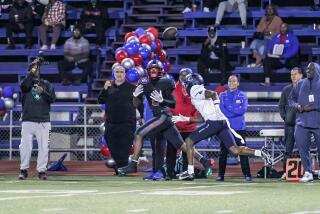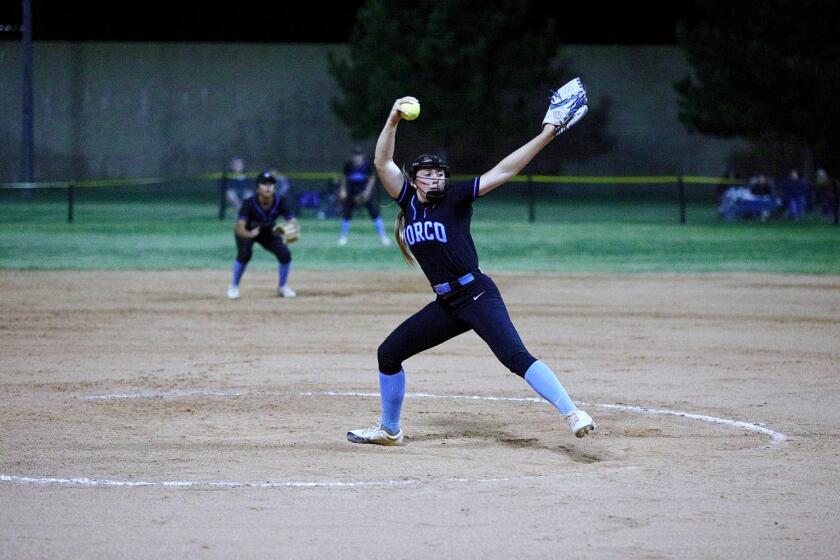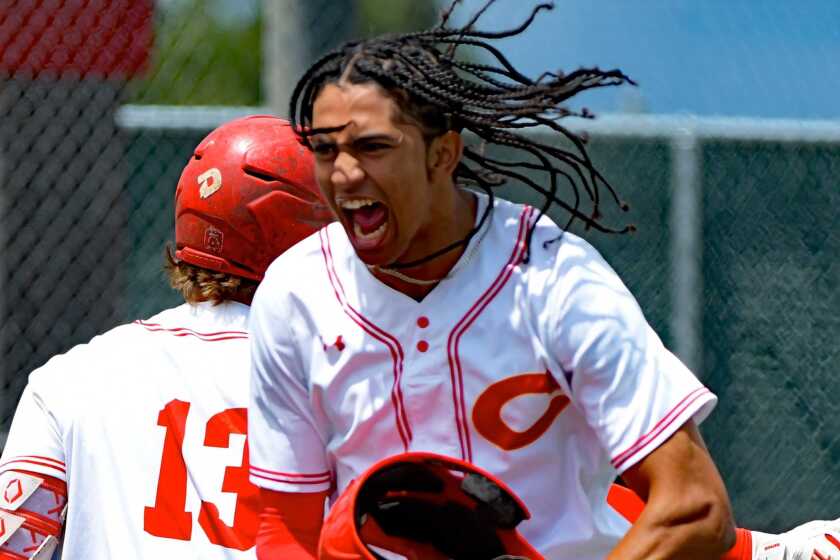The Receiving Line : High School Coaches Welcome the Pass-Oriented Offense of the NFL With Open Arms--and Minds
- Share via
Last week, as Burbank High football Coach Dave Carson peered out over the practice field, he had a half-disgusted, half-sick look on his face. His offense was supposedly running its two-minute drill. But it looked like it might be a half hour or so. Somebody suggested it would be nice if the offense made its way down the field and across the goal line--while they were still young.
Of course, Carson was hardly amused.
He screamed at receivers for being in the wrong formation. He screamed at a running back for going into motion in the wrong direction. He screamed at his quarterback for reading the defense incorrectly. He screamed at an offensive lineman for falling down. Finally, he screamed at his defense for beating up his offense.
“Running our offense is much harder than it looks,” Carson said to a visitor. Certainly, it looked hard enough.
“We work on these plays over and over, but it takes our kids a long time to learn what we’re trying to do out here.”
Which is, to put it baldly, pass the football. Carson is one of a growing number of high school coaches who are putting increased emphasis on the passing game.
In 1984, Burbank passed for nearly twice as many yards (2,005) as it gained on the ground (1,031), and finished the season at 7-4.
Said Carson: “I’ve always felt that throwing the ball is a great equalizer. Not everyone will have a big offensive line or a great tailback or strong fullback, but if you can pass and catch, then you can make up what you lack physically.”
Even high school coaches whose offenses are based on the run are trying to improve their passing games.
Last year, for the first time, San Fernando gained more yardage passing than it did running--despite the fact that the Tigers ran a run-oriented wishbone attack.
“You’ve got to be able to throw the football,” said San Fernando Coach Tom Hernandez. “In the future, you’ll see more and more high school teams going to the pass.”
Gil Brandt, vice president of the Dallas Cowboys, said that high school football has been heavily influenced by the wide-open offenses in the NFL.
“We have college coaches visit our training camp every year,” Brandt said. “The colleges see what we’re doing and the high schools see what the colleges are doing.”
Indeed. Coaching clinics have become popular among high school coaches. In August, Cal Lutheran College sponsored a clinic attended by nearly 100 coaches from California, Arizona and Nevada.
In seminars, coaches were taught how to stretch defenses horizontally and vertically with a passing attack. They were versed on how to coach quarterbacks, and much attention was given to ball-control passing.
“There’s more creativity on offense now than there used to be,” said Dallas Cowboys quarterback coach Ernie Stautner, an instructor at the clinic. “The passing that is being used, even in high school, seems more complex, but it’s really more simple.”
Added Stautner: “Quarterbacks and receivers are reading what the defense is, whether it is man or zone coverage. It’s like sandlot football. The quarterback says to the receiver, ‘You run to a certain spot, but if a defender is in a certain coverage, run to an opening and I’ll hit you there.’ ”
Obviously, it’s not that simple. Brigham Young Coach LaVell Edwards believes that one of the keys to his team’s success with the pass comes from repetition during practice.
“We devote 80% of our practice time to throwing the football. We run patterns again and again. The quarterback should know where he’s throwing and why he’s throwing there.”
Some high school coaches say they hesitate to rely too heavily on passing because of time limitations.
According to Frank Greminger, coach at Agoura, many coaches try to develop a strong passing game but never perfect it because they have too few coaches to instruct players.
“You’ll never see the same precision in high school as you see in the pros and college,” he said. “We just don’t have enough time to spend on it.”
Although Greminger runs the veer at Agoura, he managed to find enough time in practice last season for his team to pass for 1,733 yards. The Chargers’ passing, combined with an effective running game, led to a 14-0 season.
“Well,” Greminger said, “we work on it some.”
National Football League rule changes, which Brandt said spawned the throwing upsurge, don’t apply to high school football, however.
In the NFL, offensive linemen can extend their arms with open hands to block passes. In high school, that is a violation.
Additionally, NFL pass defenders can bump a
receiver only once--and only within five yards of the line of scrimmage. High school rules allow a defender to bump all he wants, as long as the ball is not in the air.
Dick Schindler, assistant director of the National Federation of State High School Athletic Assns., a notoriously conservative group, said the high school rules could eventually be changed.
High school rules are voted on by the federation’s 50 representatives--one from each state. It takes a two-thirds vote to change a rule.
“There’s more pressure on us now to open up our rules a little,” Schindler said. “In my opinion, we will have a change in the blocking rule and possibly the pass defense rule.
“That will encourage even more passing in high school.”
Harry Welch, coach at Canyon, disagreed. “I don’t think the rules have as much effect as people say they do,” he said.
What has had an effect on high school passing programs, according to Welch, is summer passing leagues. In the passing leagues, teams play 7-on-7 non-contact football, although an occasional accidental stick has been known to slip in here and there.
“We play almost 30 games over the summer,” Welch said. “The skill-position players really benefit from it.”
Apparently so. Welch’s team had a 14-0 record last year. In addition to Canyon’s 2,610 rushing yards, the Cowboys tacked on another 2,207 yards passing.
Back at Burbank, Carson’s two-minute offense finally scored. And as soon as the extra point was kicked, the offense wanted to go 80 yards back the other way.
They had another half hour.
Carson turned and asked: “You think they’d want to go again if we were running it up the middle?
“That’s the thing about this offense. It’s not boring. It’s a helluva lot of fun.”






